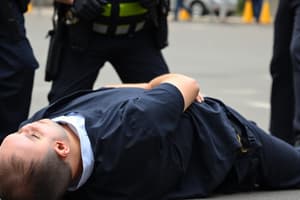Podcast
Questions and Answers
Which of the following is considered an acceptable type of force that an officer may use?
Which of the following is considered an acceptable type of force that an officer may use?
- Use of excessive verbal commands
- Deadly force without reason
- Verbal harassment
- Less than lethal force (correct)
What defines the circumstances under which an officer is allowed to use a choke-hold?
What defines the circumstances under which an officer is allowed to use a choke-hold?
- If it is the only means to prevent imminent serious physical injury (correct)
- Only when all other methods of control have failed
- For crowd control in public gatherings
- When the officer feels intimidated by the individual
Which of the following situations does NOT justify the use of force by an officer?
Which of the following situations does NOT justify the use of force by an officer?
- To protect oneself from unlawful violence
- To enforce lawful detention of a suspect
- To prevent an unlawful entry into a property
- To maintain personal dignity against verbal disrespect (correct)
What constitutes the 'duty to intervene' for an officer?
What constitutes the 'duty to intervene' for an officer?
Which of the following is a medical requirement post-use of force?
Which of the following is a medical requirement post-use of force?
Which option describes a training requirement for officers regarding use of force?
Which option describes a training requirement for officers regarding use of force?
Which option is NOT a type of force recognized in police use of force policies?
Which option is NOT a type of force recognized in police use of force policies?
What is the primary purpose of implementing force by police officers?
What is the primary purpose of implementing force by police officers?
What is the main purpose of the annual Use of Force Report prepared by the Office of Professional Responsibility?
What is the main purpose of the annual Use of Force Report prepared by the Office of Professional Responsibility?
How often must Self-Aid Buddy Aid (S.A.B.A) training be completed by sworn personnel?
How often must Self-Aid Buddy Aid (S.A.B.A) training be completed by sworn personnel?
Who is responsible for addressing policy violations after reviewing the ‘Response to Resistance Report’?
Who is responsible for addressing policy violations after reviewing the ‘Response to Resistance Report’?
What is included in the annual training conducted by the Training Bureau regarding the use of deadly force?
What is included in the annual training conducted by the Training Bureau regarding the use of deadly force?
What should occur if the investigating supervisor finds that the force used was justified and no policy violations occurred?
What should occur if the investigating supervisor finds that the force used was justified and no policy violations occurred?
When are marked patrol units required to be equipped with a basic medical kit?
When are marked patrol units required to be equipped with a basic medical kit?
What key element does Self-Aid Buddy Aid (S.A.B.A) training focus on?
What key element does Self-Aid Buddy Aid (S.A.B.A) training focus on?
What factors are assessed in the annual Use of Force Report prepared by the Office of Professional Responsibility?
What factors are assessed in the annual Use of Force Report prepared by the Office of Professional Responsibility?
Under what circumstance is the use of physical force permitted according to the policy?
Under what circumstance is the use of physical force permitted according to the policy?
What is the primary purpose of the policy regarding the use of force by officers?
What is the primary purpose of the policy regarding the use of force by officers?
What must officers realize about the unnecessary use of force?
What must officers realize about the unnecessary use of force?
According to the use of force policies, what must the level of physical force be?
According to the use of force policies, what must the level of physical force be?
What is critical for officers to consider before applying physical force?
What is critical for officers to consider before applying physical force?
What must all officers do after using or threatening to use force for an arrest?
What must all officers do after using or threatening to use force for an arrest?
What is one consequence of an officer exercising unnecessary force?
What is one consequence of an officer exercising unnecessary force?
In a scenario where officers must intervene, what is their responsibility regarding the use of force policies?
In a scenario where officers must intervene, what is their responsibility regarding the use of force policies?
What is the title required for the initial incident report regarding use of force?
What is the title required for the initial incident report regarding use of force?
Which report is necessary when deadly force is utilized in a search warrant execution?
Which report is necessary when deadly force is utilized in a search warrant execution?
What underlying principle should guide officers in their response to resistance?
What underlying principle should guide officers in their response to resistance?
Which option correctly defines the types of force that require documentation?
Which option correctly defines the types of force that require documentation?
What constitutes the 'threat of force' under the described use of force policies?
What constitutes the 'threat of force' under the described use of force policies?
In the context of use of force, which of the following is considered a non-deadly force technique?
In the context of use of force, which of the following is considered a non-deadly force technique?
What is required from the Initial Reporting Officer after an instance of recorded force?
What is required from the Initial Reporting Officer after an instance of recorded force?
Which of the following statements accurately reflects the duty to intervene in the use of force scenarios?
Which of the following statements accurately reflects the duty to intervene in the use of force scenarios?
Under what conditions is an officer authorized to use deadly force?
Under what conditions is an officer authorized to use deadly force?
Which of the following methods of restraint is prohibited?
Which of the following methods of restraint is prohibited?
What is a requirement before an officer can utilize a method of restraint?
What is a requirement before an officer can utilize a method of restraint?
Which scenario does NOT justify the use of firearms?
Which scenario does NOT justify the use of firearms?
In what situation is deadly force acceptable according to the guidelines?
In what situation is deadly force acceptable according to the guidelines?
What may be used in an emergency situation to protect an officer's life if no approved weapon is available?
What may be used in an emergency situation to protect an officer's life if no approved weapon is available?
Which rule is there about firing from a moving vehicle?
Which rule is there about firing from a moving vehicle?
What guides the use of force policies for officers in violent situations?
What guides the use of force policies for officers in violent situations?
Flashcards are hidden until you start studying
Study Notes
Types of Force
- Types of force that officers may use include mere presence, verbal direction, physical contact, less than lethal methods, and deadly force.
Justifications for Using Force
- Force can be justified for preserving peace, preventing offenses, making lawful arrests, self-defense, or protecting property possession.
Medical Aid Post-Force
- Medical treatment must be provided to individuals injured during an incident involving force, those requesting aid, or those having adverse reactions.
Prohibited Uses of Force
- Chokeholds or carotid-control holds are restricted unless they are necessary for self-defense against imminent threats of serious injury or death.
Duty to Intervene
- Officers are required to intervene, either verbally or physically, to prevent potential harm or inappropriate actions by other officers.
Purpose of Use of Force Policy
- The policy aims to guide officers in using force judiciously, avoiding unnecessary applications that may lead to civil or criminal liability.
Use of Force Procedures
- Immediate supervisors must review reports on use of force, addressing any policy violations and ensuring adequate training.
Annual Use of Force Reporting
- An annual report on use of force incidents is required to analyze trends and identify training or policy needs.
Annual Deadly Force Training
- Annual training is mandated for officers on the proper use of deadly force and firearms.
Self-Aid Buddy Aid (S.A.B.A)
- Basic life support training is mandatory for sworn personnel every two years to manage medical emergencies until help arrives.
Reporting Use of Force
- Officers must create detailed reports for any use or threatened use of force, ensuring accuracy and comprehensiveness in documentation.
Approved Restraints
- Only Department-issued and approved restraint devices can be used, excluding methods that could severely restrict movement, such as "hog-tying."
Justifications for Deadly Force
- Officers can use deadly force if there is a reasonable belief of an immediate threat to life, aligned with Texas Penal Code Section 9.51.
Restrictions on Firearm Use
- Firearms must not be discharged as warnings, from moving vehicles, or at fleeing vehicles, unless serious threat to life is present.
Studying That Suits You
Use AI to generate personalized quizzes and flashcards to suit your learning preferences.



